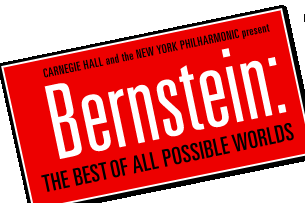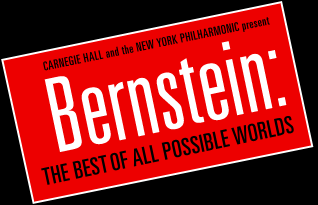
THE MASS PROJECT:
A LISTENING TOUR
Bernstein’s Mass
The 1970s saw a number of religious rock musicals, notably Jesus Christ Superstar and Godspell, and Bernstein was so impressed by the latter that he invited 23-year-old writer Stephen Schwartz to provide lyrics for Mass—once again, Bernstein reached beyond his own world of classical music for a collaborator to help him create a large-scale musical theater piece, as he had with West Side Story.
Mass was Bernstein's most ambitious theater work. Despite its adaptation of the Latin text interspersed with songs, "numbers," choreographic sequences, and symphonic interludes, Mass is ecumenical in nature and cannot be categorized. Perhaps the most accurate description of the piece is "pageant." With approximately 200 performers, including dancers, singers, a boy chorus, rock and blues singers, actors, and two orchestras, as well as a marching band—who play through the audience—Mass is a musical and theatrical experience.
Take a guided listening tour of Bernstein's Mass—with audio excerpts and commentary by composer and arts educator Thomas Cabaniss.
Mass Section |
Notes |
Audio Excerpts and Commentary |
I. Devotions Before Mass1. Antiphon: Kyrie Eleison2. Hymn and Psalm: “A Simple Song” 3. Responsory: Alleluia |
A cacophony of quadraphonic sounds gets things spinning in an unusual direction. Then, the stillness and the beauty of a very simple idea stands in stark contrast to the cacophony, setting up the idea of unfettered belief. | |
II. First Introit (Rondo)1. Prefatory Prayers2. Thrice-Triple Canon: Dominus vobiscum III. Second Introit1. In nomine Patris2. Prayer for the Congregation (Chorale: “Almighty Father”) 3. Epiphany |
The world invades the mass and its sanctuary. The conflict within the mass has now begun. The celebrant strengthens his relationship with his own congregants, making it clear that there's a world of the church, and it's being invaded by others. | |
IV. Confession1. Confiteor2. Trope: “I Don't Know” 3. Trope: “Easy” |
The piece begins to slowly unravel. The confessors have guilt and shame, but they're not sure that the church is giving them what they need. | |
V. Meditation No. 1 (Orchestra) |
Bernstein explores some of the musical issues of atonality and 12-tone music in this first orchestral interlude. | |
VI. Gloria1. Gloria Tibi2. Gloria in Excelsis 3. Trope: “Half of the People” 4. Trope: “Thank You” |
A moment of fun, youthful energy, connecting the celebrant and the youth chorus, leads into the most direct assault on church doctrine. The street chorus proclaims direct assault on belief, with a quatrain by Paul Simon: “Half the people are stoned and the other half are waiting for the next election / Half the people are drowning and the other half are swimming in the wrong direction.” | |
VII. Meditation No. 2 (Orchestra) |
How do you respond to direct assault? Bernstein's second mediation allows both audience and celebrant a moment of contemplation. | |
VIII. Epistle: “The Word of the Lord”IX. Gospel-Sermon: “God Said” |
The celebrant decides to continue the mass, but the street chorus interrupts the sermon without his permission, questioning belief and faith, and accusing the church of hypocrisy. | |
X. Credo1. Credo in unum Deum2. Trope: Non Credo 3. Trope: “Hurry” 4. Trope: “World Without End” 5. Trope: “I Believe in God” |
The celebrant tries to restore order, which leads to further mayhem. Instead of a statement of belief (Credo), the audience hears a statement of non-belief—a reflection on feelings of personal abandonment from God leads into the issue of why God has abandoned the environment. Now the younger generation asks, “What's in it for me and how does it relate to my life?” This is the first time the celebrant begins to lose his temper with the congregation. | |
XI. Meditation No. 3 (De Profundis, part 1)XII. Offertory (De Profundis, part 2) |
This meditation is filled with angst and anguish; even the orchestra seems to be rebelling. While everything spins out of control, the celebrant sits alone at a piano reciting a very personal and intimate statement of belief. | |
XIII. The Lord's Prayer1. Our Father ...2. Trope: “I Go On” |
The celebrant wonders, "What do I believe, and how do I answer all these questions that this congregation and these people from the world have asked me?" | |
XIV. SanctusXV. Agnus DeiXVI. Fraction “Things Get Broken”: |
The voices of the youth choir appear, giving the possibility of hope once again. The street chorus interrupts the mass and demands to know, "If there's a God, why doesn't he just fix the problems in the world?" The celebrant loses his temper, breaking and smashing sacramental vessels, and finally collapses. | |
XVII. Pax: Communion (“Secret Songs”) |
The celebrant rejoins to the world in a very moving ending in which the children of the youth chorus reach out and bring him back to the fold. | |
|
Full audio commentary with music examples |
© 2001–2008 Carnegie Hall Corporation
- Home
- |
- Multimedia
- |
- Press
- |
- Partners
- |
- Supporters





